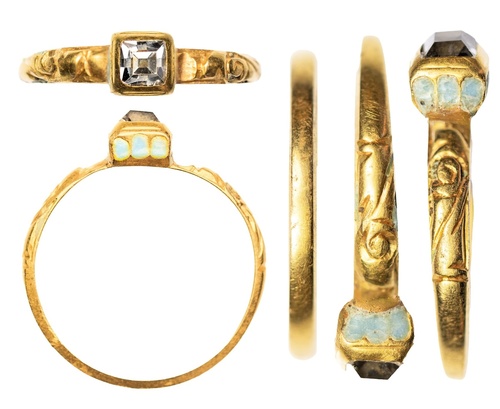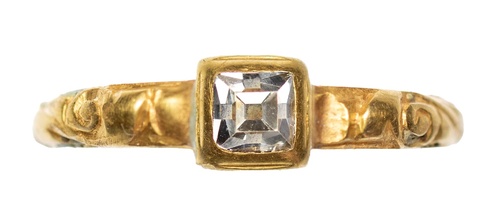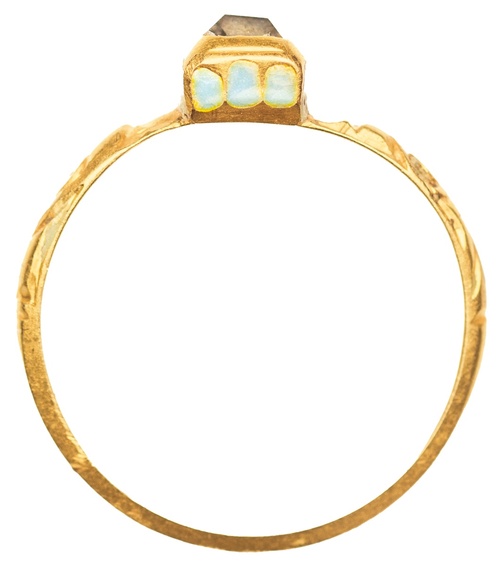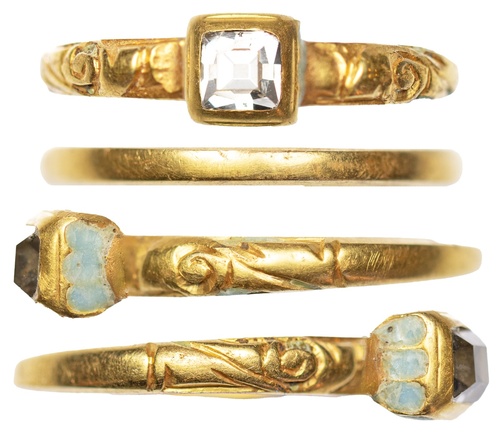Auction: 25004 - British and World Coins and Medals
Lot: 256
The Wealden Ring | An Early Post-Medieval Diamond and Enamel Ring (c. 1550-1650), the central table-cut diamond (~ 0.6ct) set within a raised box bezel made of sheet gold decorated with three tongue-shaped cells of pale blue-green enamel to all four sides, the shoulders of D-shaped cross section decorated with vine scroll pattern, with traces of blue-green enamel surviving, the design terminates halfway down the side of the hoop, the lower section of the hoop plain and with trapezoidal cross section, diameter 17.54mm, width 3.03mm, thickness 1.14mm, 2.48g, ring size approx. O, [Spink XRF: 80.7% Gold; 10.7% Silver; 8.6% Copper] (cf. Cheapside Hoard, Museum of London, No. A14244; cf. PAS: SUR-ED1CD5, PAS: WMID-2A18B1; cf. V&A 935-1871), a complete, wearable, and typically characteristic example of an early 17th century gem set ring, opaque white enamel discoloured over time, the diamond likely sourced from India and cut in France, a breathtaking survivor with a stunning, sparkling diamond that takes centre stage, an extremely rare opportunity to own a museum worthy example, unearthed in East Sussex only two years ago
Provenance
Found by a metal detectorist in Fletching near Sheffield Green, Wealden (East Sussex), 2023,
~ Recorded with the British Museum (ref. PAS-SUSS-EEFEA6) ~
https://finds.org.uk/database/artefacts/record/id/1115542
According to XRF analysis, the gold purity is 80.7%, or 19.4 carats - likely of 'the touch of Paris' standard
The stone's thermal conductivity has been tested, and the reading for a diamond was positive.
"[the very best diamonds] must be without any faults, both in corners and sides, clean cut without any nastiness, and of a good water crystalline, and shining clear, not yellow, bluish, or blackish or brown, but clear, and clean in all perfection." (Hannibal Gamon, The Goldsmith's Storehouse)
The Wealden Ring dates to c.1550-1650 and can be compared to others recorded with the Portable Antiquities Scheme including the Selbourne Ring, found in Hampshire (SUR-ED1CD5), and another found in Staffordshire (WMID-2A18B1), which was acquired by the Stoke Potteries and Art Gallery in 2018. Both examples were set with rock crystal however, rather than with diamond.
Whereas the English official gold standard set by Act of Parliament in 1576 was 22 carats, the standard in France was 19.2 carats, which became known as the 'touch of Paris'. The Wealden Ring obviously aligns more closely with the latter, suggesting that it is quite likely the ring was made abroad before making its way over to the British Isles.
One of the defining features of this ring is the tongue-shaped cells filled with enamel that surround the bezel. Now a blue-green colour, it is assumed that this enamel was once opaque white, and since discoloured. One of the Wealden Ring's closest comparable examples is a similar ring found amongst the 1912 Cheapside Hoard of 17th Century jewels, now housed in the Museum of London (A14244). That ring has white enamel decoration the entire way around the bad, as well as on the bezel, suggesting that it was custom made for the wearer, as resizing after such decoration would not have been possible. The Wealden Ring, too, is decorated with scrolls of vines, typical of gem set rings of the period, but it is plain beyond the shoulders. There are some traces of remaining enamel in the moulded relief, but most has been lost to time and erosion.
The true star of The Wealden Ring, however, is the diamond. In an age when lab grown diamonds push their way into the jewellery market by force, a natural specimen in such a flawless condition, makes for staggering viewing. The setting of the diamond in the bezel makes it difficult to estimate an exact weight, but from initial measurements it would appear the stone is somewhere between 0.5-1 carats. The gem (which likely heralded from India) is table-cut with scissor cut facets and is an incredibly rare survivor - just like its Cheapside comparable.
The global paths which led to the construction of this ring, harks to Queen Elizabeth I's fervour for colonialism, as she sent explorers like Sir Francis Drake and Sir Walter Raleigh on expeditions around the world. This diamond is representation of heady competition between European powers, as countries such as England and Spain raced across the seas to establish territories and plunder for new materials of exceptional quality.
Sumptuary laws at the time indicate that the owner of such a piece would have to have been owned by someone of considerable rank. The find spot of the ring is also particularly interesting, near Sheffield Green in Uckfield, close to Sheffield Park. Now a sprawling garden landscaped by Capability Brown and owned by The National Trust, it was once an important ancient estate. It was mentioned in the Domesday Book, had been owned by Dukes, Lords, and Earls. Even Henry VIII came to Sheffield Park, in August 1538, when he was hosted by the 3rd Duke of Norfolk, Thomas Howard. In the surrounding fields and farms, there were further residences that date to the Medieval period. At the time of production, this area was clearly both housing and hosting wealthy members of society, and we can only wonder at exactly who may have owned and lost the ring. What we can tell, is that they cannot have had it long, as there is hardly any wear showing.
Literature
National Trust. 1995. Sheffield Park Garden, The History from the 1983 Survey.
Auble, C. 2011. The Cultural Significance of Precious Stones in Early Modern England, University of Nebraska-Lincoln.
Forsyth, H. 2013. The Cheapside Hoard: London's Lost Jewels, Museum of London. London.
Gosling J.G. (1995) The Cheapside confusion. Journal of Gemmology, Vol. 24, No. 6, pp. 395-400.
Jobbins A.E. (1991) The Gemmology of the Cheapside Hoard. Goldsmiths Technical Digest 1990/91. The Worshipful Company of Goldsmiths, London, pp. 22-25.
Subject to 20% VAT on Buyer’s Premium. For more information please view Terms and Conditions for Buyers.
Sold for
£40,000
Starting price
£10000











